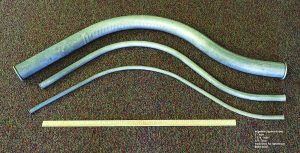For some of us growing up on the farm where surface irrigation was prevalent, the irrigation siphon tube has been and still is utilized to irrigate crops across Nebraska and the world. Learning how to “set” the siphon tube, moving the tubes from set to set, field to field, “digging (row) ends,” and dealing with ditch washouts, gophers, moles, mosquitoes, and other critters does not always bring back fond memories!
What is an irrigation siphon tube? The tubes can be constructed of plastic (earliest models), rubber, polyethylene, and aluminum. Visualize it as a “stretched C.” One end can have a lengthened end or not. The length of the tube can vary from approximately four feet to 14.3 feet. I can be thankful that I only had to deal with the four-foot lengths.
The size/diameter of the siphon tube used by the grower was dependent on the length of the row (run), slope of the field, row spacing, time of the “set” (how long the tube ran), and the flow rate. A field with a slope on a hillside will use a siphon tube with a small diameter to minimize soil erosion in the furrow. A field with little slope, a long run, and a longer set time will use a larger diameter siphon tube. The length time of the set is determined by the length of the run and the flow rate of the siphon tube. The grower wants to make sure there is enough water reaching the end of the field long enough to water the crop while not overwatering the upper end of the field. This is not the most efficient method of irrigation water application. But where there are small, irregular shaped fields where a center pivot or sub-surface drip irrigation is not feasible, siphon tubes work well. The siphon tubes are used to draw water out of a dirt/soil formed ditch or a concrete-lined ditch. The water is backed up by using a canvas/polyethylene dam for dirt or concrete-lined ditches or a checkboard for concrete-lined ditches.
How does an irrigation siphon tube work? For ease of explanation, it works by a difference in the “head” of the water. The “head “is defined as the height difference between the surface of the water in the ditch and the outlet of the water from the siphon tube. The head can vary from several inches to ten inches. When setting a siphon tube, you need to get most or all the air out of the tube by covering the outlet with the palm of the hand and creating a vacuum, then drawing the tube over the edge of the ditch and releasing the palm of the hand below the water surface level in the ditch into the furrow. If a good seal is not done, the tube will not run or not flow well. The higher the head, the greater the amount of flow out of the tube until the maximum amount of flow is reached.

Nebraska Extension / 4H takes part in the annual WET (Water Education for Tomorrow) program for Panhandle fifth graders. Extension teaches students the importance of water as a limited resource, where it comes from, basic irrigation methods, and crop water use. The fun part of that portion is trying to teach the students how to set a siphon tube. Water flies everywhere!
The number of siphon tubes and the size (diameter) to use with a given amount of water in the ditch is a bit art and science. Again, the length of the run, the time of the set, and the slope of the field all come into play. It would be a bit of trial and error the first few times until the grower has a good idea of what to do. If you think about it, the siphon tubes are “self-regulating.” By that, I mean as the surface water level in the ditch goes down, the head decreases, and the flow rate in the siphon tubes decreases. So, the key is to find the right combination of the number of tubes of the correct diameter (general flow rate) to manage the amount of water in the ditch.
Who invented the siphon tube? Records indicate soldiers at Fort Sidney, Neb., may have used siphon tubes to irrigate gardens. There are a number of claims for the invention, but it is acknowledged that Milo German made the siphon tube practical and popular for growers. Records indicate Milo German, a Nebraska native from Cozad, Neb., refined the concept of the siphon tube in 1942 and began manufacturing them in partnership with the then John Deere dealership in Cozad. In 1945 he began marketing the siphon tubes using COZAD as the brand name under his new company name Nebraska Plastics, Inc. For that period, using siphon tubes in place of lath-boxes set in the side of the ditch saved growers time and labor. As time passed, growers started using more efficient forms of gated pipe, center pivot, and subsurface drip irrigation systems. Siphon tubes are still manufactured, and the irrigation siphon tube is still in use worldwide today.

